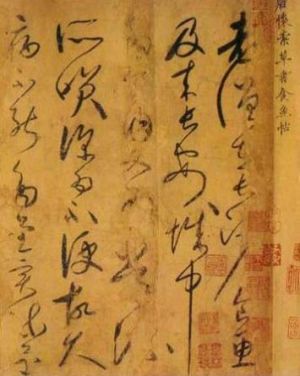Huai Su
Huai Su was a monk and calligrapher, who had loved calligraphy from childhood and was famous for his caoshu (cursive hand). He wrote so much that he wore out numerous brushes and ink-slabs, so he began to use the leaves of banana trees, which he grew himself, instead of paper. He called his studio “House of Green Skies.” At first he studied the calligraphy of Zhong You and the two Wangs. Later he learned the cursive script of Zhang Xu from Yan Zhenqing and created his own style of cursive hand, becoming a famous cursive-hand calligrapher like Zhang Xu, one known as “wild Zhang” and the other as “drunken Su.”
The wild cursive hand (kuangcao) is a style that is written completely freely. The product expresses his feeling and will through the brushwork, which is extremely concise and often links several words in single stroke. It is the most extreme form of the cursive hand. Huai Su’s style has more variations than that of Zhang, without violating traditional rules. It is also more recognizable and so had a greater influence than Zhang on the following generations. The Zi xu tie (Su Ben Autobiography Scroll) is considered to be his best work.
The scroll had been written in several copies. The original is kept in the Taipei Palace Museum, Taiwan Province.
According to the author’s note at the end of the scroll, it was produced when he was 41, in the prime of his life. The text describes his studies of calligraphy and experiences in creation. The latter part records praise by Yan Zhenqing and others.
His cursive hand is sometimes mixed with seal characters, and the brushwork is done mostly with the middle edge of the brush, round and turning inwardly, presenting a feeling of strength, flow and change. The spaces are well distributed and the size of the characters, large and small, spreading out and confined, seems to be produced at will freely but the space between them, the form, the size and the bulkiness and dryness of characters are well coordinated and laid out. A balanced beauty is thus achieved in the dynamic characters. This work is clearly modeled on Zhang Xu’s style, but it is less wild than Zhang’s works. Huai’s style was greatly influenced by Wang Xianzhi.
